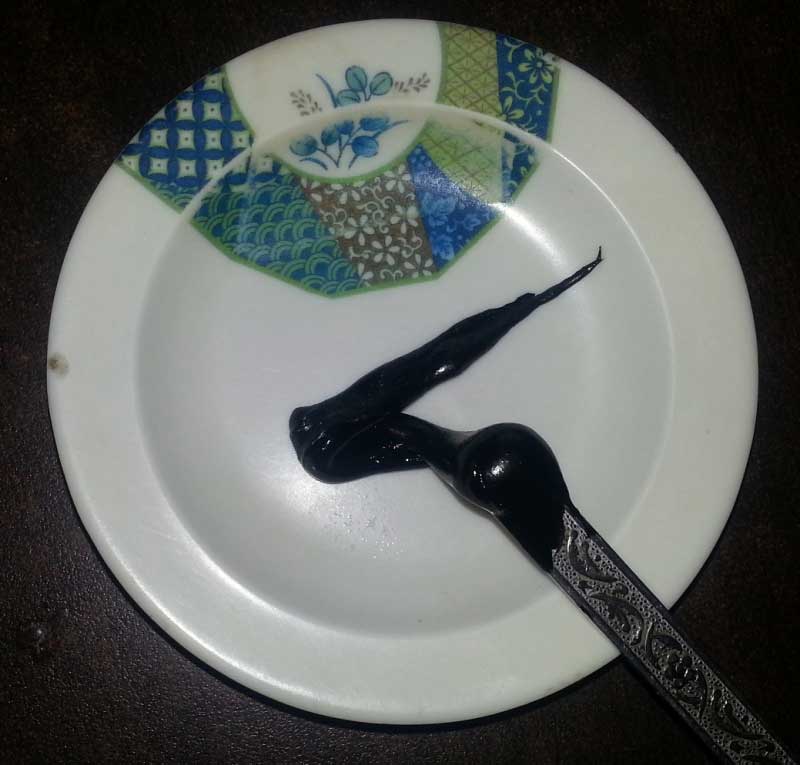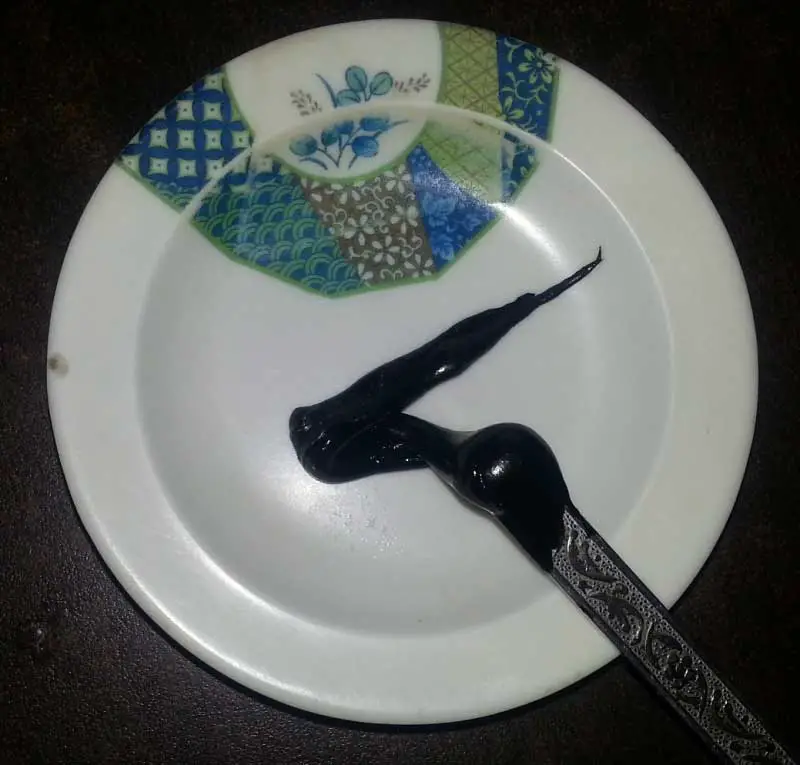What is Shilajit?
Shilajit is a waxy or resinous substance that can be found in mountainous rocks at high altitudes, usually in the 1000-5000 metre range. Shilajit is typically produced in India, Nepal, Pakistan, Tibet, and Russia, in mountain ranges such as the Himalayas, Caucasus, and Hindu Kush. However, “Andean shilajit” has also been found in Chile. Warm temperatures in the summer cause the shilajit, formed of minerals and decomposed plant matter, to squeeze out from between the rocks, allowing it to be harvested.
Shilajit is known as a treatment or supplement in Ayurveda, the traditional system of medicine in India. Raw shilajit resin has a pale brown to black color, a smell reminiscent of bitumen or urine, and a bitter taste. While resin can be purchased, the most common forms of shilajit available today are capsules and powders. It is also known as salajeet, mumie, mummiyo, or “mineral wax,” a catchall term that can refer to other substances as well, such as ozokerite, a cosmetics additive.
Shilajit Benefits and Uses
In Ayurveda, shilajit was considered a “conqueror of mountains and destroyer of weakness.” It was primarily used as a strength and vitality enhancer, and is mentioned in the Charaka Samhita, the main text of Ayurveda. Although there are few clinical trials that reliably prove shilajit’s benefits, studies back up some of its traditional uses as well as other potential benefits, including the following:
Mood Booster
Shilajit is not only a natural mood stabilizer but also an adaptogen. It’s well known for its ability to balance serotonin and dopamine levels.
High fulvic acid content
Up to 80% of shilajit is humic acids, with fulvic acid as the main component. Fulvic acid is a natural compound that occurs in soil, sediment, and aquatic zones, and is produced when organic materials decompose and release bacteria. Because it contains these beneficial bacteria, as well as trace minerals, electrolytes, and fatty acids, fulvic acid can help your body better absorb nutrients, improve gut health, and promote faster recovery from infections. Fulvic acid also has a low molecular weight, so it can be easily absorbed by your digestive system and eliminated from the body within hours.
Fertility enhancement
In a study at Chungbuk National University in South Korea, healthy rats were given 25, 50, and 100mg/kg of shilajit daily. After six weeks of the 100mg dosage, increases in sperm of 130% and 378% were found in the testes and epididymis, respectively, of male rats. In female rats, increased estrus, improved oocytes, and more frequent ovulation was observed. Meanwhile, a human trial gave men with low sperm counts 200mg of shilajit (55% fulvic acid) daily for 90 days. It was found that the men developed increased volume and sperm count, better motility, and increased percentages of non-defective sperm.
Libido enhancement
In the same study, wherein men were given 200mg daily of shilajit, a nearly 24% increase in testosterone was observed after 90 days. Shilajit also increased levels of follicle-stimulating hormone (FSH – an important reproductive hormone in men and women) by 10%, although it had no effect on the luteinizing hormone (LH). Shilajit has traditionally been used in the Himalayas as a libido enhancer.
Cholesterol reduction
Healthy adults who consumed 2g of shilajit per day observed a 22% decrease in triglycerides, a 23% decrease in LDL cholesterol, a 21% decrease in vLDL cholesterol, as well as a 6% increase in HDL cholesterol.
Decreased perception of pain
In one example, a hot water tail flick test (this measures the time taken for a mouse to flick its tail in response to the pain of hot water) using mice who had taken shilajit, showed decreases in their pain responses. Another test of mice injected with 0.1 and 1mg/kg of shilajit found that it decreased the need for morphine as a painkiller. However, shilajit itself is not necessarily a painkiller.
Possible Alzheimer’s benefits
Fulvic acid can help damage a protein called tau, which is partly responsible for the development of Alzheimer’s.
Eczema treatment
One study of individuals who received fulvic acid applied to the skin, twice daily for two weeks, observed significant improvements in eczema symptoms, even compared to standard emollient therapy. The only reported side effect from fulvic acid applied to the skin was a mild burning sensation which faded quickly.
The fulvic acid in Shilajit has known anti-inflammatory properties, and is an antioxidant, which destroys disease-causing free radicals. Therefore, it has many potential applications throughout the body. Additional possible benefits include ulcer reduction, improved digestion, improved blood glucose levels for diabetics, enhanced cognition and anti-anxiety benefits. Reportedly, shilajit has also been used by Eastern European weightlifters as an ingredient in an “herbal anabolic stack” to promote strength, muscle growth, and recovery. Meanwhile, the traditional Ayurvedic uses for shilajit are varied. They include treating altitude sickness, genitourinary disorders, digestive disorders, anemia, anxiety, bronchitis, and a host of other problems.
Shilajit Side Effects and Safety
In appropriate doses, shilajit does not appear to have toxic effects in healthy individuals. In a fertility study performed at Chungbuk National University, it was found that 100mg/kg for six weeks did not affect organ weight in rats. The human fertility study using 200mg for 90 days in men also did not note any toxicity from shilajit. Additionally, a further human study using a dose of 2g a day for 45 days did not observe toxic effects. However, there are a number of safety guidelines that should be followed carefully when taking shilajit supplements.
- Since shilajit has a high concentration of fulvic acid, it should not be taken with chlorinated water, as chlorine can negatively interact with the acid.
- Individuals with diabetes should be aware that shilajit may lower blood sugar levels.
- Shilajit may also lower blood pressure.
- Individuals with phenylketonuria should not take shilajit, as it contains small amounts of phenylalanine.
- Shilajit may increase uric acid production, so those with uric acid retention problems should avoid it.
There has been no safety testing done for pregnant women or those with compromised immune systems, so shilajit should be avoided in these cases.
Did you know? Shilajit is great for Libido (Sex Drive), Cholesterol, and Alzheimers? Get it => https://t.co/COmMw34XC9
— MedicinalHerbals (@MedicinalHerbal) February 28, 2017
Unfortunately, it has been found that certain imported shilajit supplements are contaminated with heavy metals such as lead, mercury, and arsenic. Additionally, they can include high levels of fillers because natural shilajit is a scarce commodity. Because of these issues, the sale of shilajit has been banned in Canada. However, if you choose to buy shilajit online, make sure you are buying from a reputable seller and manufacturer, and be aware of any disclaimers that state you will be exposed to heavy metals when taking the product.

Raw or unprocessed shilajit should also be taken with caution, as it can contain fungi such as Aspergillus niger, which can cause lung and ear infections in humans, as well as other possible contaminants. These facts make safely consuming shilajit difficult, but remember that shilajit itself is not toxic—it is only the contaminants that can make it so.
How to Take Shilajit
Traditionally, shilajit was eaten with milk at breakfast time. Today, it is often found in capsule or powder form for convenience, with one or two capsules taken

per day as a continuous supplement. It has been found that some people respond better to shilajit than others, so if you have been taking it for two months with no obvious effects, you may want to stop and move on to another herb.
Shilajit and fulvic acid have an unpleasant taste, so you might find it easier to consume
them with food. This is also a safety measure you may want to take, as shilajit is best begun in a small, diluted dose, in case of any unexpected side effects and to allow your body to adjust.
Final Thoughts on Shilajit
When researching shilajit, it is common to find disclaimers warning that it has not been proven effective in treating any diseases in humans. This is true, but it does not necessarily mean that shilajit is useless or will harm you. Most of the time, this refers to diseases traditionally treated by shilajit in Ayurveda, such as respiratory illnesses or anxiety. Most of these diseases have not been evaluated alongside shilajit in clinical trials, and thus the reported benefits of shilajit can only be understood within the context of Ayurveda.
In traditional Ayurveda, taking herbal remedies was only part of the recovery process. Because disease was primarily seen as an impediment to carrying out religious obligations (such as fasting, celibacy, and penances), Ayurvedic medicine had a significant religious context that has simply been removed today. Even within the portion that is still practised, there are numerous intricacies that are best navigated by someone who has studied Ayurveda. Since in most countries there is no licensing process to become an Ayurvedic practitioner—most people simply study it independently—so make sure you are choosing a trustworthy individual. This person may also be able to help find reliable sources of shilajit.
Therefore, while shilajit should not be relied on as your primary source of care for any specific illness, it can be taken safely as a supplement to promote overall health and wellness, to boost your immune system and to allow you to experience the benefits of fulvic acid.
References:
http://www.ncbi.nlm.nih.gov/pmc/articles/PMC3296184/
http://www.ncbi.nlm.nih.gov/pmc/articles/PMC3609271/
http://onlinelibrary.wiley.com/doi/10.1002/ptr.5018/abstract
http://www.ncbi.nlm.nih.gov/pmc/articles/PMC3326792/
http://onlinelibrary.wiley.com/doi/10.1111/and.12482/abstract
http://onlinelibrary.wiley.com/doi/10.1002/ptr.2100/abstract
http://www.ncbi.nlm.nih.gov/pmc/articles/PMC3330960/pdf/ASL-23-114.pdf




